The Limits of Tolerance
The films of Bertrand Bonello all center on desire's inseparability from basic modes of exchange, the impossibility of arriving at some form of pure expression of human need. His latest film, L'Apollonide (Souvenirs de la maison close), is no exception. Since Bonello's films are quintessential documents of the 20th century (they hesitate, I believe, to envision what the 21st will bring), the mode of exchange that intercedes on desire's behalf is, of course, capitalism, or, in the specific parlance of L'Apollonide, "commerce." Bonello's film is attentive to the rituals and social relations within a Parisian brothel (or "house of tolerance," in official jargon) without turning those relationships into metaphors for or blatant microcosms of the larger situation of women of the era. In fact, it seems that part of the initial resistance to L'Apollonide—it met a rather chilly reception when it premiered at Cannes—pertains to its relative restraint in terms of politicizing the sex work of its day, or staking out a clearly delineated feminist position.
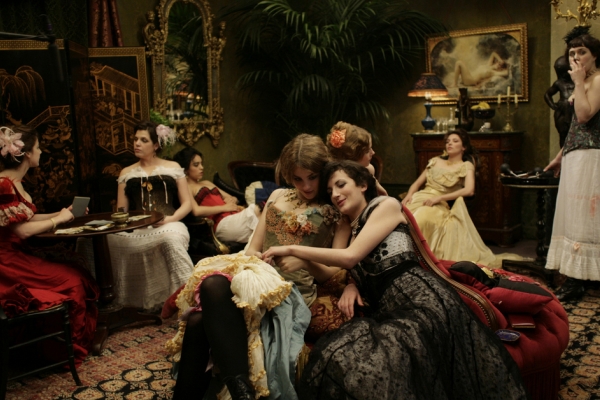
L'Apollonide (Souvenirs de la maison close)
But Bonello does have a position on these issues. It just cannot be the sort that draws the clean lines to which 50-odd years of political pandering have made us so accustomed. L'Apollonide is, first and foremost, a film about a community of women, subjects whose relative lack of agency is perhaps more visible than that of other turn-of-the-century individuals who, to varying degrees, are being redefined by broad historical shifts. Even accounting for Bonello's high degree of stylization—the lush camerawork, the Romantic sweep, the strategic anachronism—L'Apollonide postulates the brothel as a kind of laboratory or crucible for highlighting (as Bonello's title cards state) the twilight of the 19th century and the dawn of the 20th.
Only through gradual immersion does Bonello slowly inculcate us into the basic social and economic structure of L'Apollonide, the titular house of tolerance. (House of Tolerance is the original English language title; the film's distributor has saddled it with the more marketable but far less indicative moniker House of Pleasures.) Partly by way of a 16-year-old novitiate, Pauline (Iliana Zabeth), the other women along with the proprietress Marie-France (Noémie Lvovsky) explain the basic operation of the house. One of the major elements of the job, discussed repeatedly, is that there are fundamental tools of the trade—perfumes, astringents, mouthwash, soaps—that must be purchased from the house, along with room and board. Therefore, the longer a woman works at the brothel, the more debt she accumulates, on top of whatever financial straits may have led her to the maison close in the first place. While the women occasionally engage in sexual "shop talk" in their off-hours (e.g., discussing why Julie [Jasmine Trinca] has the nickname "Caca"), they are all much more engaged in conversations about finances and credit.
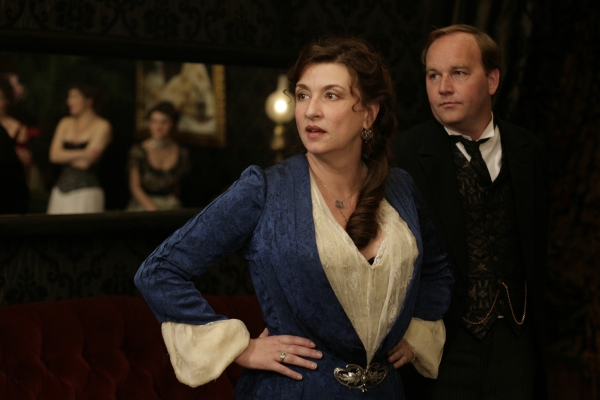
Noémie Lvovsky in L'Apollonide (Souvenirs de la maison close)
In this regard, Bonello makes it absolutely clear that Marie-France, however benevolent, is the owner of the "means of copulation"—the client base, the chateau, the capital investment. Likewise, when the taxes are raised on the house, we hear a voiceover reading of a letter Marie-France writes to a councilman for her arrondissement, reminding him that she is a single mother of two trying to make ends meet. (Her request for a tax break is refused.) She is therefore in a highly ambivalent relationship to power, being indebted to a somewhat larger domestic macro-economy, one that keeps the gaslights on and the permits in order. But perhaps more importantly, Bonello shows that she is a broker of sorts, since the clientele of L'Apollonide are ostensibly in the position to take their favored sex workers away from the house, by paying off their outstanding debts. This is a fantasy for many of the less-jaded women of the house, one that certain cynical clients like Julie's patron, Maurice (played by filmmaker Jacques Nolot), continually encourage. (In a somewhat different cultural context, the same false promises and economic/sexual rent-to-own incentive plans were depicted in Hou Hsiao-hsien's 1998 masterwork Flowers of Shanghai, a film from which Bonello drew direct inspiration.) Bonello, then, is depicting the death throes of the old 19th-century courtesan system as it runs headlong into modernity's more mercenary modes of capitalism, with (in Foucault's terms) the largely individualized concentration of sex-exchange bio-power.
The stakes involved in this rupture, and what the end of L'Apollonide and the tolerance system means for the women of the house, is so deeply ambivalent, and Bonello's depiction of it so circumscribed within its own limited historical horizon, that the initial misunderstanding of L'Apollonide by some critics is somewhat understandable. From a certain vantage point, Bonello could be seen as romanticizing or eroticizing the brothel. The dark, burnished interiors of the house, the green-gray fleur-de-lis wallpaper, golden laps and picture frames, mahogany poster beds and plush crimson sitting-room furniture, are all lovingly attended by Josée Deshaies's opulent cinematography. Often, slow pans and tracking shots seem to mimic Mark Lee Ping Bing's languorous imagery from Flowers of Shanghai. What's more, Bonello is not coy about the display of female flesh. There are frequent shots of the women in groups, dressing, bathing, or lying around with one another, in varying states of undress. On first blush, these scenes could seem cheaply fetishistic, or appear to partake of the stereotype that sex workers are somehow hypersexualized beings, given to random Sapphic frolicking in the off-hours.
But what we actually find is that, until the film and the house are nearing their end, L'Apollonide is a sisterhood. The women are mutually supportive, and show genuine affection for one another. Even though the accessories of their trade put them in debt to the madam, they still share. They swap stories about strange or irksome clients. They discuss their hopes and aspirations. And yes, they brush each other's hair and scrub each other's backs.
In Bonello's construction of the brothel as a community rather than simply a space of oppression, the depiction of Madeleine (Alice Barnole) is probably the single most crucial element. Madeleine's complicated life in L'Apollonide instigates the film's most complex formal interventions; she is at the center of several flashbacks and a looping time structure that entails the opening 10 or so minutes of the film repeating in the middle, dispersed across other scenes. At first, Madeleine is called The Jewess. She has an encounter with a trusted regular client (Laurent Lacotte) in which she describes a joyful dream of being so (ful)filled with semen that she secretes it through her tear ducts. The man ties her up, with permission, and begins teasing her with a straight razor. Eventually he mutilates her face, slashing her mouth open at both sides.
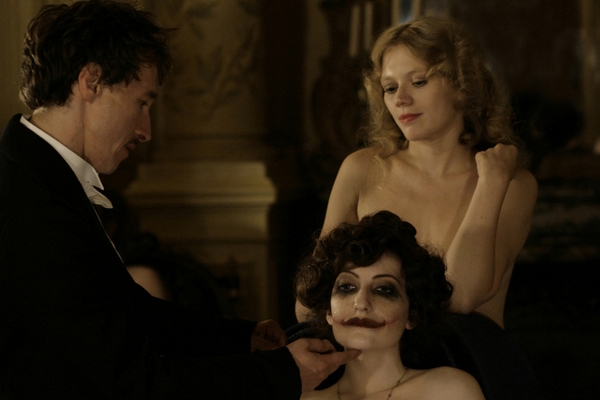
Alice Barnole in L'Apollonide (Souvenirs de la maison close)
Bonello selects Madeleine's predicament as a kind of linchpin for the collapse of the cloistered commerce that the 19th-century house of tolerance represents. Throughout the film, we learn that Marie-France never turns her out. She stays on, keeping house, doing laundry, cooking and cleaning. While this is no ideal life, it is clear that only an economic system that retains some degree of gentility and honor, rather than the coming Gilded Age, would find an employer taking responsibility for Madeleine's well-being, having been injured due to "company" negligence. But more importantly, Madeleine, as far as the other women in the house are concerned, is family. While she jokes about being a "freak," the others will not brook such talk. By contrast, as the house enters financial straits and the laws begin to change, Madeleine is forced to take work outside the house, to try to help Marie-France and the others. An odd client (director Xavier Beauvois) spies her at L'Apollonide and recruits her, dubbing her The Woman Who Laughs. She is hired for a sexual tableau, alongside a little person; she is ogled by aristocrats, who describe her as a "giant doll" or a "puppet," and strip her down for sport.
However materialist and Foucauldian he may be, Bonello is still enough of a humanist to provide Madeleine with true redemption. The last night of the brothel, a Bastille Day masked ball, permits her a measure of sexual ecstasy, complete with tears of milky white cum. (For their part, her friends take delicious revenge on the man who attacked her.) But overall, Madeleine's fortunes outside the house are a small taste of what the 20th century has to offer these women. Sex work, under the tolerance system, was labor, with all its attendant dangers and exploitations. These women were not free. The system's collapse was not a cause, or an effect, but one node in an overall shift to a modernity characterized by greater repressiveness, shifting modes of social surveillance and control, and (in Linda Williams's terms) an "implantation of perversions." The clientele becomes more furtive and increasingly violent; the slashing of Madeleine's face is a harbinger of male attitudes to come. As L'Apollonide's precautions break down, Julie contracts syphilis and slowly dies. (Her wake, at which her sister-workers dance to the anachronistically placed "Nights in White Satin" by The Moody Blues, is probably the film's defining scene, a send-off for an entire way of life.) In L'Apollonide's controversial final shot, Bonello jump-cuts to the present day, and ugly consumer-grade video. We see streetwalkers near an overpass, one hopping out of a Renault hatchback. There are three or four of them out on the street. They don't even look at each other.
L'Apollonide is unquestionably Bonello's finest achievement to date. But Bonello has been exploring the conjunction between sexuality and material transactions throughout his career. It is, in essence, his primary subject as an artist. Granted, as I'll address below, he has explored these questions with mixed results. Bonello's oeuvre is somewhat uneven. But I think that one of the reasons he has not been better known among the North American cinema cognoscenti is that, unlike some of his peers—Catherine Breillat, Gaspar Noé, Bruno Dumont, Christophe Honoré—Bonello avoids strong, sensational statements about sexuality and gender, but also abjures the kind of studied apoliticism that is fashionable in certain circles, a headlong rush away from anything that might carry even the whiff of the didactic. (Consider that in the final flashback to Madeleine's assault, she is shown very clearly stating that she no longer consents to play-violence with the razor, that whatever her fantasy may have been, her attacker has crossed the line. Such delineation would probably seem schoolmarmishly "p.c." to the likes of Noé or even Breillat.)
In early work such as The Pornographer (2001), Bonello examines sexually explicit filmmaking as a mere subset of artistic creation in general, without ever soft-pedaling the explicit facts of hard-core porn: the scenes of non-simulated penetration most likely kept it out of the U.S. marketplace. Jacques Laurent (Jean-Pierre Léaud) plays a retired porn auteur whose heyday is behind him. Film studies researchers and cinematheque devotees have plucked him from relative obscurity (he seems ever-so-loosely based on Radley Metzger), and he has the chance to work again. But as the excruciating on-set sequence makes clear, Laurent's artistic sensibility has no place in the contemporary industry. He directs Jenny (French adult actress Ovidie) to visualize her orgasm rather than screaming, and to swallow her co-star's semen instead of taking a facial. None of these gestures toward subtlety will stand, however. Before long, Jacques's much-younger producer Louis (André Marcon) takes over the shoot, reversing the director's every decision. "You're too old for this business," he chides.
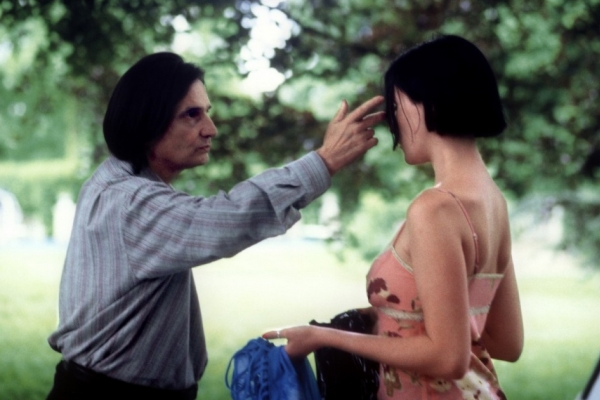
Jean-Pierre Léaud and Ovidie in The Pornographer
If The Pornographer has one major flaw, it's that Bonello invests too much stock in Jacques's integrity as an artist. Although the film is fairly clear-eyed about the kitsch factor within his most sincere ideas—his last great, unrealized film, The Animal, entails a foxhunt, with a naked woman as the quarry!—The Pornographer is still indebted to certain romanticist pieties regarding art vs. commerce. Here, sex becomes less a medium of exchange than a limit of representation, the last frontier of semiotic truth. Bonello's other films about the creative process tend to view desire and exchange in more sophisticated terms. His short film Cindy, the Doll is Mine (2005), for example, examines a hypothetical Cindy Sherman photo shoot, in which the legendary postmodern artist and deconstructor of female identity is literally split in two. Asia Argento plays a more straitlaced, masculine Cindy behind the camera, giving directions to her model, a "Cindy" in a blond baby-doll wig and farm-girl dress. The interaction between the two veers from the psychological to the mundane, with the photographer coaxing her model to cry one minute, offering her a sandwich the next. In some sense, Bonello avoids the mock-heroic pitfalls of The Pornographer by eliminating intersubjectivity. There is no "exchange" between the Cindys, given that they are two sides of the same identity.
Probably Bonello's least successful effort, 2008's On War, is ironically his most ambitious. A story that starts out in what appears to be semi-autobiographical territory, the film features a director named Bertrand (Mathieu Amalric) who, after getting locked overnight in a coffin during a location-scouting accident, meets nightwatchman Charles (the late Guillaume Depardieu), who encourages him to drop out of the professional rat race, abandon his partner Louise (Clotilde Hesme), ostensibly for only two weeks, and come to a country retreat where he can discover true joy. Detailing the multiple plotting machinations of On War would be both time-consuming and rather ridiculous, but Bertrand finds himself increasingly in thrall to a bourgeois cult of battle-ready hedonists who are preparing for a nondescript war against the larger society. Their charismatic leader, Uma (Asia Argento), is a student of Clausewitz. The film is Bonello's least meaningful and most star-studded, featuring Elina Löwensohn, Léa Seydoux, Aurore Clément, Laurent Lucas, and a Brandoesque cameo by Michel Piccoli. It's also Bonello's most unabashed declaration of cinephilia. In addition to an early scene in which Bertrand cancels an appointment with an escort so he can watch eXistenZ (1999) on TV, there is an extended passage that riffs on Apocalypse Now (1979), a reverse tracking shot that quotes Gus Van Sant's Last Days (2005), and an ambience saturated with the idealistic putrefaction of Godard's Weekend (1967). What do we find in On War? Ultimately, a sense of Bonello's major insights turned inside out. The search for authentic pleasure, for full Heideggerian Dasein among the privileged set, leads to another (romantic) fantasy of the end of labor and exchange. But within the film, all it generates is charismatic authority. As for the film itself, it marshals significant resources of the French industry only to lavish them on wanton folly, an achievement after a fashion.
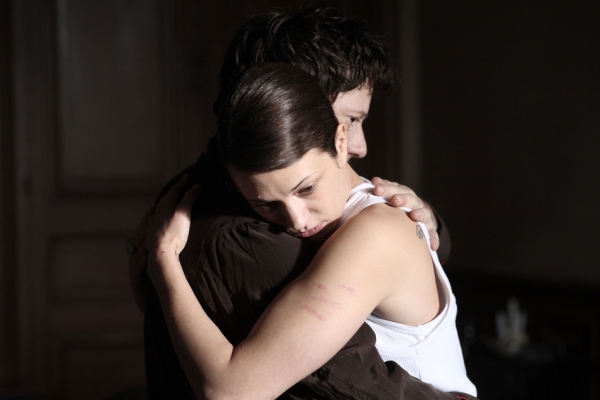
Mathieu Amalric and Asia Argento in On War
As you can see, it's the creative process (moviemaking in particular) that represents a kind of hang-up for Bonello, which is to be expected, I suppose. By contrast, his 2003 film Tiresia, which received an even worse reception at Cannes and has undergone no substantial reevaluation, reflects an excoriating interrogation of male sexual power as an exchange structure in which a select few hold all the cards. The first half of Tiresia finds a mysterious man, played by Laurent Lucas, tending a garden and cruising a pickup spot for transgender sex workers. In voiceover, we hear his thoughts on the nature of aesthetics, and the aesthetics of nature; he explains that "the original is vulgar, because of its past; the copy is perfect." His internal monologue has the terse, frenzied tenor of an obsession, a warped philosophy that, once put into action, will wind up hurting somebody, and indeed it does. He takes home Tiresia (Clara Choveaux), a Brazilian "whore" (as she calls herself), whom he soon imprisons. Each night he ties her arms to the bedpost above her head, sleeping with her like a lover.
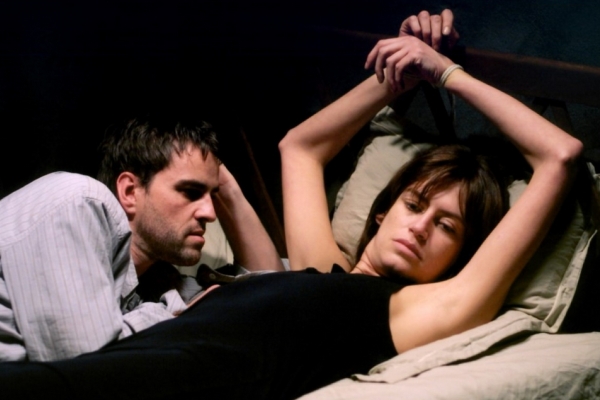
Laurent Lucas and Clara Choveaux in Tiresia
In time, the hormones in Tiresia's system deplete, and she begins to show male characteristics, like facial hair. Disgusted, but unable to let her go for fear of legal reprisal, the kidnapper gouges her eyes out with a pair of scissors and leaves her for dead. In the second half of Tiresia, a young girl named Anna (Célia Catalifo) rescues Tiresia (now masculine, played by Thiago Telès) and brings him home. Like the mythical prophet of Thebes, blind Tiresia now has unbidden visions of the future. Stylistically, Bonello's film shifts from the underlit violence and perversion of Fassbinder to the open skies of the French countryside, the everyday-miraculous of Bruno Dumont. But what doesn't change is the fact that Tiresia, in both realms, is a liminal figure. Her ability to emigrate from Brazil, and her continued ability to maintain a life as a woman, are directly tied to sex work. Her body is traversed by transnational economic exchange, and, as her assailant is no doubt aware, her undocumented status (to say nothing of being transgendered) makes her his perfect victim, as well as his forbidden object of desire. What's more, as Bonello shows, Tiresia's movement through "the twilight" of the 20th century and "the dawn" of the 21st has made her as susceptible as anyone to the implantation of modern perversions, most notably self-hatred and outside definition of her body and its desires. "Look at what I am," she says, undressing before Lucas's character during a sponge bath. "It's inhuman. It's disgusting." (And it should be noted, to Bonello's credit, that Tiresia's transgendered body is fully displayed, as a beautiful yet quite ordinary human form.) Of course, Tiresia shows us quite clearly, through its acts of raw savagery, who is inhuman in this scenario.
In a cruel but unsurprising irony, the second half of Tiresia reveals that Lucas's vicious, repressed transphobe, a true child of the post L'Apollonide era, is Father François, the village priest. His medium of exchange, then, is both cash money (in the night) and transcendence (at the pulpit by day). In either case, Tiresia is a threat to his supremacy. The ultimate guarantor of value, then, becomes the Phallus, even more than the almighty franc or Euro; no wonder the houses of tolerance, with their tentative sisterhoods, had to be collapsed into an atomized walking to the boulevards. Tiresia's eyes, Madeleine's mouth—Bonello, ever the optimist, shows them resisting butchery by continuing to see and speak to the power before them. In some respects, L'Apollonide is Tiresia's prequel. ![]()
LATEST ARTICLES
-20140814-173707-thumb3.jpg)
Fighting Words
by Imogen Sara Smith
posted August 12, 2014

Fighting Words, Part 2
by Imogen Sara Smith
posted August 20, 2014

On the Margins: The Fil…
by Andrew Chan
posted August 12, 2014

Robin Williams: A Sense…
by David Schwartz
posted August 12, 2014
 The Limits of Tolerance
The Limits of Tolerance
THE AUTHOR
Michael Sicinski is a film writer and teacher based in Houston, Texas. He is a frequent contributor to Cinema Scope, Cineaste, and GreenCine Daily.
More articles by Michael Sicinski
